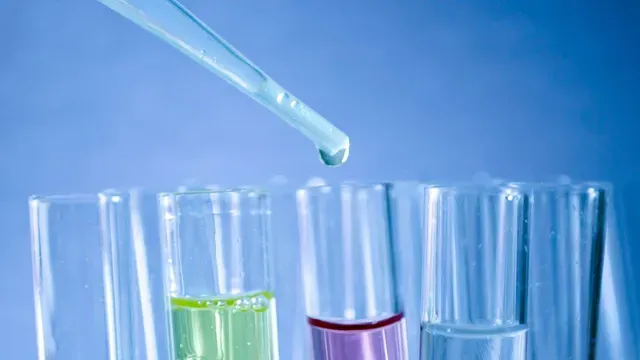This activity
explains how can we identify acids and bases using different indicators
Testing Acids and Bases Using Indicators
Aim of the Activity
To
test different acids and bases using different indicators.
Procedure
1) Collect the following samples from the science laboratory – hydrochloric acid (HCI) sulphuric acid (H2SO4), nitric acid (H2SO4), nitric acid (HNO3), acetic acid (CH3COOH), sodium hydroxide (NaOH), calcium hydroxide [Ca(OH)2], potassium hydroxide (KOH), magnesium hydroxide [Mg(OH)2], and ammonium hydroxide (NH4OH).
2) Put a drop of each of the above solutions on a watch glass and test with a drop of the following indicators as shown in the table.
Table
Sample solution | Blue litmus solution | Red litmus solution | Phenolphthalein solution | Methyl orange solution |
|
|
|
|
|
Procedure: Put a drop of each solution on a watch glass and test with a drop of all the indicators.
Observations
After performing the activity we can observe the colour changes that are given in the table
| Sample | Blue litmus solution | Red litmus solution | Phenolphthalein | Methyl Orange |
|---|---|---|---|---|
| `HCl`, `HNO_3`, `H2_SO_4` | Changes to red | No colour change | Colourless | Changes to red |
| `NaOH`,`Ca(OH)_2` `KOH`,`Mg(OH)_2` `NH_4OH` | No change | Change to blue | Change to light pink | Change to yellow |
Conclusion
The
given solutions were identified as acids or bases on the basis of their
reactions with different indicators. As acids and bases show colour changes with
these indicators.
This
activity confirms that different indicators help distinguish between acids and
bases very effectively.
Precautions - This activity needs the teacher’s assistance.
You can watch video of this activity
Frequently Asked Questions
1: What is the aim of the activity?
Ans – The aim of activity is to find whether the solutions are acidic or basic in nature.
2: What are the reagents (pH indicators) used in Activity?
Ans- Blue Litmus Paper, Red Litmus Paper, Phenolphthalein, and Methyl Orange are used as indicators of activity.
3: What changes do you notice when blue litmus is added to solutions
Ans- Blue Litmus turns red in acidic and remains blue in basic.
4: What colour change does Phenolphthalein undergo in basic solutions.
Ans- Phenolphthalein turns pink in basic solutions.
5: How does Methyl Orange behave in different solutions
Ans- Methyl Orange changes colour depending on the pH of the solution: below pH 3.1 it is red, and above pH 4.4 it is yellow.
6. What is the observation of activity?
Ans- Different indicators show colour change when added to a solution and show their acidic or basic nature. See the observation table above.
7. Blue litmus paper is dipped in a solution it remains blue what is the nature of the solution explain.
Ans- When blue litmus paper is dipped in a solution and it remains blue, the solution is basic in nature.
8. Sodium hydroxide turns blue litmus into which colour?
Ans - Sodium hydroxide turns blue litmus red colour
9. ‘Sodium hydroxide turns blue litmus red’, is this true or false?
Ans- It is true
10. Dry HCl gas does not change the colour of dry blue litmus paper, why?
Ans-HCl shows acidic character in the presence of water so dry HCl gas does not change the colour of dry blue litmus paper.
11. Which solution does not turn blue litmus into red?
Ans- A basic or alkaline solution does not change blue litmus into red.
12. What happens to blue litmus paper when it is dipped in vinegar?
Ans- Vinegar contains acetic acid which is a mild acid, so blue litmus paper gets turned into red when dipped in vinegar
13. Which of the following substances turns blue litmus red?
Base, acid, salt or alkali
Ans- Acid
14. What do you observe when blue litmus solution is added to water?
Ans – The `P^H` of Pure water is 7 which is neutral so there is no colour change when blue litmus is added to water.
15. In which colour does `CO_2` turn blue litmus paper?
Ans - `CO_2` gas is acidic in nature so it turns blue litmus paper into red.
16. if a solution turns blue litmus red, then its PH is likely to be?
Ans- Its PH is likely to be below 7 because acidic solutions turn blue litmus red.
17. What change will you observe if you test soap with litmus paper red and blue
Ans- Soap solution is basic in nature so colour will not change with blue litmus paper and red litmus paper changes to blue.
18. Window cleaners turn red litmus blue. what is its nature?
Ans- If window cleaners turn red litmus blue then they are basic in nature.
19. What will happen when calcium hydroxide reacts with blue litmus paper?
Ans- Blue litmus remains blue because calcium hydroxide is basic in nature.
20. What does it mean when blue litmus paper stays blue?
Ans- When blue litmus paper stays blue, it means that the substance being tested is either neutral or basic in nature.
Related Topics
1. Activity 2.2
.jpg)

.jpg)



No comments:
Post a Comment